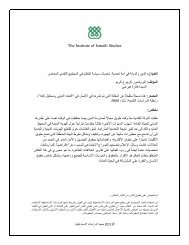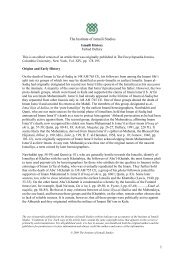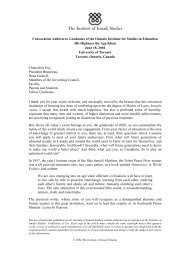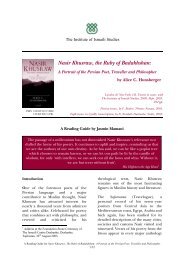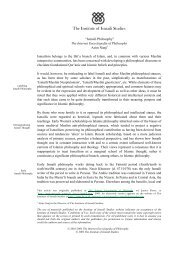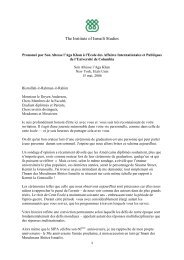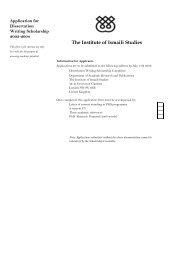BM-IIS Conference Pack.qxp - The Institute of Ismaili Studies
BM-IIS Conference Pack.qxp - The Institute of Ismaili Studies
BM-IIS Conference Pack.qxp - The Institute of Ismaili Studies
Create successful ePaper yourself
Turn your PDF publications into a flip-book with our unique Google optimized e-Paper software.
<strong>BM</strong>-<strong>IIS</strong> <strong>Conference</strong> <strong>Pack</strong>.<strong>qxp</strong> 20/03/2009 14:13 Page 22<br />
<strong>of</strong> articles and reviews on many aspects <strong>of</strong> Islamic art, particularly the arts <strong>of</strong> the Islamic<br />
Mediterranean region and the history <strong>of</strong> paper in the Islamic lands. Among his recent<br />
books is Arts <strong>of</strong> the City Victorious: Islamic Art and Architecture in Fatimid North Africa and<br />
Egypt, published in 2007 by Yale University Press in association with <strong>The</strong> <strong>Institute</strong> <strong>of</strong><br />
<strong>Ismaili</strong> <strong>Studies</strong>.<br />
RUBA KANA‘AN<br />
“Between Realm and Resonance: ‘Fatimid Style’ in Yemen and Oman”<br />
<strong>The</strong> artistic style <strong>of</strong> the Fatimid Shi‘is was the product <strong>of</strong> evolution and consolidation.<br />
Fatimid style came to be recognised for its use <strong>of</strong> particular architectural elements,<br />
decorative motifs, and inscriptions. This style was emulated and reproduced<br />
throughout the Fatimid realm and well beyond the Fatimid period. This paper<br />
examines the articulation and resonance <strong>of</strong> Fatimid style in Southern Arabia with a<br />
focus on a group <strong>of</strong> stucco-decorated mihrabs (prayer niches) dating between the 11th<br />
to the 16th centuries in Yemen and Oman. While Yemen was part <strong>of</strong> the Fatimid realm<br />
under the Sulayhids (1038-1138), its neighbour Oman was not. Oman was ruled by<br />
Ibadhi Imams whose interpretation <strong>of</strong> Islamic doctrine was different from that <strong>of</strong> the<br />
Shi‘is and Sunnis. More specifically, the paper will discuss the mihrab <strong>of</strong> the Great<br />
Mosque <strong>of</strong> Jibla in Yemen commissioned by the Sulayhid Queen Arwa bint Ahmad in<br />
1087 and the mihrab <strong>of</strong> the Great Mosque <strong>of</strong> Sa’al in Oman dated to 1252. This paper<br />
demonstrates how these and other mihrabs share a common decorative and structural<br />
language, despite doctrinal and political differences between Yemen and Oman.<br />
Ruba Kana‘an (DPhil (Oxford)) is currently Noor Visiting Chair <strong>of</strong> Islamic <strong>Studies</strong> at<br />
York University, Toronto. She has held the posts <strong>of</strong> Dean and Research Fellow at the<br />
Oxford Centre for Islamic <strong>Studies</strong>, Faculty Member <strong>of</strong> Oriental <strong>Studies</strong> and Research<br />
Fellow at the University <strong>of</strong> Oxford, and Visiting Fellow at the Aga Khan Programme for<br />
Islamic Art at Harvard University. Her current research includes the socio-legal<br />
development and artistic influences on the historical mosques <strong>of</strong> Oman, and the<br />
interface between art and law in Muslim contexts. Her recent publications include “<strong>The</strong><br />
de jure Artist <strong>of</strong> the Bobrinski Bucket: Production and Patronage <strong>of</strong> pre-Mongol<br />
Metalwork in Khurasan and Transoxiana”, and “<strong>The</strong> Carved-Stucco Mihrabs <strong>of</strong> Oman:<br />
Form, Style and Influences”. She is currently co-editing a book on Places <strong>of</strong> Worship and<br />
Devotion in Muslim Societies for Berghahn Press and completing a volume entitled Ten<br />
Masterpieces <strong>of</strong> Islamic Art for Saqi Books.<br />
NASSER RABBAT<br />
“Maqrizi and the Fatimids”<br />
Paper Abstracts and Academic Biographies<br />
After the fall <strong>of</strong> the Fatimids, Egyptian historiography tended to either ignore them or<br />
to call them al-‘Ubaydiyyun as a rejection <strong>of</strong> their claim to a Prophetic lineage. In that<br />
charged scholarly environment, it was audacious to cast the Fatimids in a positive light,<br />
and very few Egyptian ‘ulama did. <strong>The</strong> most prominent among them was Taqiyy al-Din<br />
Ahmad ibn ‘Ali al-Maqrizi (1364-1442), the historian with the most expansive repertoire<br />
<strong>of</strong> his generation, if not the entire 15th century, <strong>of</strong> Mamluk historiography. In two <strong>of</strong><br />
his compendia, al-Mawaiz wa-al-I‘tibar bi-Dhikr al-Khitat wa-al-Athar and Itti‘az al-Hunafa<br />
bi-Akhbar al-A’imma al-Fatimiyyin al-Khulafa, Maqrizi <strong>of</strong>fers a flattering portrayal <strong>of</strong> the<br />
Fatimids and their achievements. In the Khitat, he lauds their Caliphate and describes<br />
the many spectacular structures and the order and decorum it established in Egypt. In<br />
the Itti‘az, which is a chronicle <strong>of</strong> the Fatimid period, he mounts a fervent defense <strong>of</strong><br />
the authenticity <strong>of</strong> their lineage and urges his readers to “examine the facts fairly and<br />
not be deceived by the fabrications <strong>of</strong> the Fatimids’ detractors.” In this paper, I will<br />
analyse Maqrizi’s writing on the Fatimids, highlight its uniqueness in Egyptian<br />
historiography, and <strong>of</strong>fer several plausible reasons for his distinct stance. <strong>The</strong>se include<br />
his own lineage, his strict and uncompromising religious doctrine, and his critical<br />
stance vis-à-vis his contemporary rulers <strong>of</strong> Egypt, the Circassian Mamluks.



